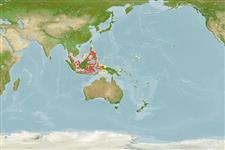>
Blenniiformes (Blennies) >
Blenniidae (Combtooth blennies) > Salariinae
Etymology: Ecsenius: Greek, exenios, -os, -on = uncontrolled, immoderate; tricolor: Name from the Latin 'tri-' meaning 3, and 'color', referring to the three stripes on the head; noun in apposition.
Environment: milieu / climate zone / profondeur / distribution range
Écologie
marin démersal; profondeur 1 - 10 m (Ref. 48636). Tropical
Western Central Pacific: Philippines and Borneo.
Taille / Poids / Âge
Maturité: Lm ? range ? - ? cm
Max length : 6.0 cm TL mâle / non sexé; (Ref. 48636)
Description synthétique
Clés d'identification | Morphologie | Morphométrie
Has a distinctive blue-white line below the eye that usually continues over the axil to above the anus on the body, bordered by a bright orange one below over the gill section. Head deep blue, continuing and gradually changing on the body to bright orange on the tail (Ref. 48636).
Body shape (shape guide): elongated.
Adults inhabit seaward and sheltered reefs (Ref. 90102). They occur in coral rich habitats at about 10 m depth, usually among Acropora branches (Ref. 48636). Oviparous. Eggs are demersal and adhesive (Ref. 205), and are attached to the substrate via a filamentous, adhesive pad or pedestal (Ref. 94114). Larvae are planktonic, often found in shallow, coastal waters (Ref. 94114).
Life cycle and mating behavior
Maturité | Reproduction | Frai | Œufs | Fécondité | Larves
Oviparous, distinct pairing (Ref. 205).
Springer, V.G. and G.R. Allen, 2001. Ecsenius ops, from Indonesia, and E. tricolor, from western Philippines and northwestern Kalimantan, new species of blenniid fishes in the stigmatura species group. aqua, J. Ichthyol. Aquat. Biol. 4(4):151-160. (Ref. 55736)
Statut dans la liste rouge de l'IUCN (Ref. 130435: Version 2025-1)
Menace pour l'homme
Harmless
Utilisations par l'homme
Outils
Articles particuliers
Télécharger en XML
Sources Internet
Estimates based on models
Preferred temperature (Réf.
123201): 28.5 - 29.3, mean 28.8 °C (based on 721 cells).
Phylogenetic diversity index (Réf.
82804): PD
50 = 0.5000 [Uniqueness, from 0.5 = low to 2.0 = high].
Bayesian length-weight: a=0.00776 (0.00356 - 0.01695), b=3.00 (2.81 - 3.19), in cm total length, based on LWR estimates for this (Sub)family-body shape (Ref.
93245).
Niveau trophique (Réf.
69278): 2.0 ±0.00 se; based on food items.
Résilience (Réf.
120179): Haut, temps minimum de doublement de population inférieur à 15 mois (Preliminary K or Fecundity.).
Fishing Vulnerability (Ref.
59153): Low vulnerability (10 of 100).
🛈
